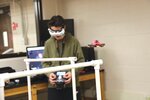
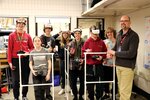
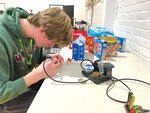
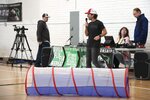
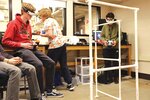

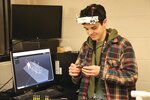

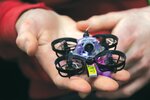

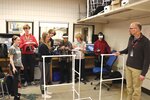
Teens at Washburn High School are learning STEM on the fly.
At their after school meet-ups for the Tiny Whoops drone team, they are learning programming for robotics, electronics, aerodynamics, and more.
Flying the Tiny Whoops drones requires fine motor skills that take some time to hone. Drone pilots learn how electrical systems work and repair their own drones, pointed out Peter Gruhl, who teaches drones and engineering classes at Washburn High. They learn how to program and configure drones. They experiment and problem solve.
The micro brushless-motor quadcopters are under eight centimeters in width and length, and just five centimeters in height (not including the antenna). The drones have a camera with mount and video transmitter onboard, and a transmitter and video receiver/display unit at the pilot end.
“There’s a lot of stuff involved,” said team captain Wesley Hearn, who flies as “Grandpa Stanley” in the Youth Drone Sports Championship (YSDC) league. Each pilot needs first-person view (FPV) goggles to see the flight path, a flight controller, a drone, motors, receiver, and batteries.
“A lot of what we do is wait for batteries to charge,” said Hearn. They use a particular type of battery that shouldn’t sit charged, and, once it is used, it is meant to be discharged quickly. This means they need a lot of batteries.
“In drone flying, you learn a lot about electronics and a little bit about flight mechanics,” said Hearn. “Soldering is a big thing.”
They start with the basics of the drone and how to take care of it. It can take some time to figure out how to get your drone in the air and keep it there. Unlike larger drones that are line of sight (meaning you look up at it, see where it is going, and control it from the ground), the 5-inch mini quads are first-person view (FPV) drones and a pilot needs to get used to controlling it remotely via a screen in their goggles or on a monitor. “You see what the drone sees in real time,” explained Hearn.
“It’s really hard to control at the start,” said team member Anders Geye. Once they get the hang of getting it up, they begin to learn how to adjust the speed and height in order to make the turns and tricks needed to get through a course.
Every Wednesday during the school year from 3:15 to 5 p.m., the team practiced on a new Micro Track Smash course set up in room 120D at Washburn High School.
The Micro Track Smash courses offer real-life racing in a basement, school classroom, or any 10-foot by 20-foot space versus teams around the country and across the globe. Participants create an official YSDC-designed track using PVC pipe from a shopping list, and then use the YSDC mobile app to track lap times. After a Micro Track Smash session, the participant uploads a digital recording of their flights from their headset for verification, instantly posting their time to the national leader boards.
The tiny size of the micro drones make them ideal for flying indoors, through shelves, and under desks – and also work outdoors. They are known for their acrobatic performance, and are capable of flips, rolls and fast climbs due to their power to weight ratio. They are efficient, with up to four minutes of flight from a tiny battery. They are inexpensive to purchase and repair, many on the market are ready to fly, and they’re portable.
Washburn team members include Hearn, Alex Pasdo, Lyla White, Ben Olney, Sam Giebink, Samuel Jones, Carson Bulliford, Rosie Bernhardt, Elijah Cox, Anders Geye, Charlie Laughhouse, Declan Migely, and Sophia Gaylord.
Other local schools with teams include Apple Valley High School and Academy of Holy Angels. Tiny Turbines began as a homeschool team focused on empowering female pilots and grew with its members, which includes college sophomore and team captain Aurora Pass. As her skills have grown, Pass has started providing live-steams of the competitions, which are posted on the YSDC YouTube account.
The YSDC has grown considerably in the last few years, and pilots from across the United States use an online simulator, the VelociDrone, to fly together.
FUN THROUGH HANDS-ON SKILLS
Hearn’s older brother, Mac, was on the drone team before he was. It was during COVID-19, and Hearn said he was looking for something to do, so he joined, too. At the time, Youth Sports Drone Championships (YSDC) had rented a third-floor space at the Mall of America and held regular practices at the RdyTechGo! space. “It was super cool there,” recalled Hearn. “We had a lot of fun every Saturday.”
For the final race of the season that year, there were multiple courses set up throughout the mall, which was emptier than usual due to the various regulations around COVID-19. “We got to walk around the mall while flying,” said Hearn.
A junior this year, Hearn is interested in aerodynamics and electrical engineering, and plans to pursue a career in that area after high school. He’s glad for the chance to gain some hands-on skills now, while having fun doing it.
‘THESE DRONES CAN TAKE BEATINGS’
Hearn and Alex Pasdo know the most about drones on the team, and answer questions the newer and less experienced members have.
“These drones can take beatings,” said Pasdo. “They can go right into walls at 20 miles per hour and be ok.”
He estimates that half of their meet-ups is programing and the other half flying. There is an in-person competition about every three weeks, and the races are broken up into three seasons during the school year – fall, winter and spring.
“It’s a nice thing to do,” said Charlie Laughhouse. “You get to hang out with your friends.”
“It’s super relaxed,” agreed Hearn. “We’re all friends.”
Declan Migely’s mom wanted him to join a club, and he was glad to discover that this one wasn’t a stressful activity.
Sophia Gaylord is one of the most recent additions to the Washburn Drone Team. “I think it’s cool,” she said. “I want to have the motor skills. It just seems like it will help with other things. I like competitions best. I’m not very good at physical sports.”
“It’s exciting when you learn how to do something with the drones because you feel smart,” remarked Lyla White, who joined the team last year. “It’s hard to do. It takes a lot of skill.”
For new racers, she has one word of advice. “If you have long hair, tie it up.” They’ve had a few mishaps where hair got caught in drone propellers.
At one race, Hearn was the only member of his team in attendance. His drone broke, and the pilots from other teams offered him various parts and advice to get it back up and running.
“We have kids that work well together but still want to win,” observed Grul.
NEW DRONE COURSE COMING AT MPS
Next year, Minneapolis Public Schools (MPS) will add a new drone robotics course for this emerging field in a completely new facility with a two-story flying space.
“There is a lot of emerging demands for drones in industry like surveying and assessment for the energy industry, communications industry, roads and bridges construction,” remarked Gabriel Pass, who will be teaching the new robotic course. “There are some fun facts like in the agriculture industry, the career that is in the intersection of highest paying/highest demand is a drone pilot.”
Comments
No comments on this item Please log in to comment by clicking here